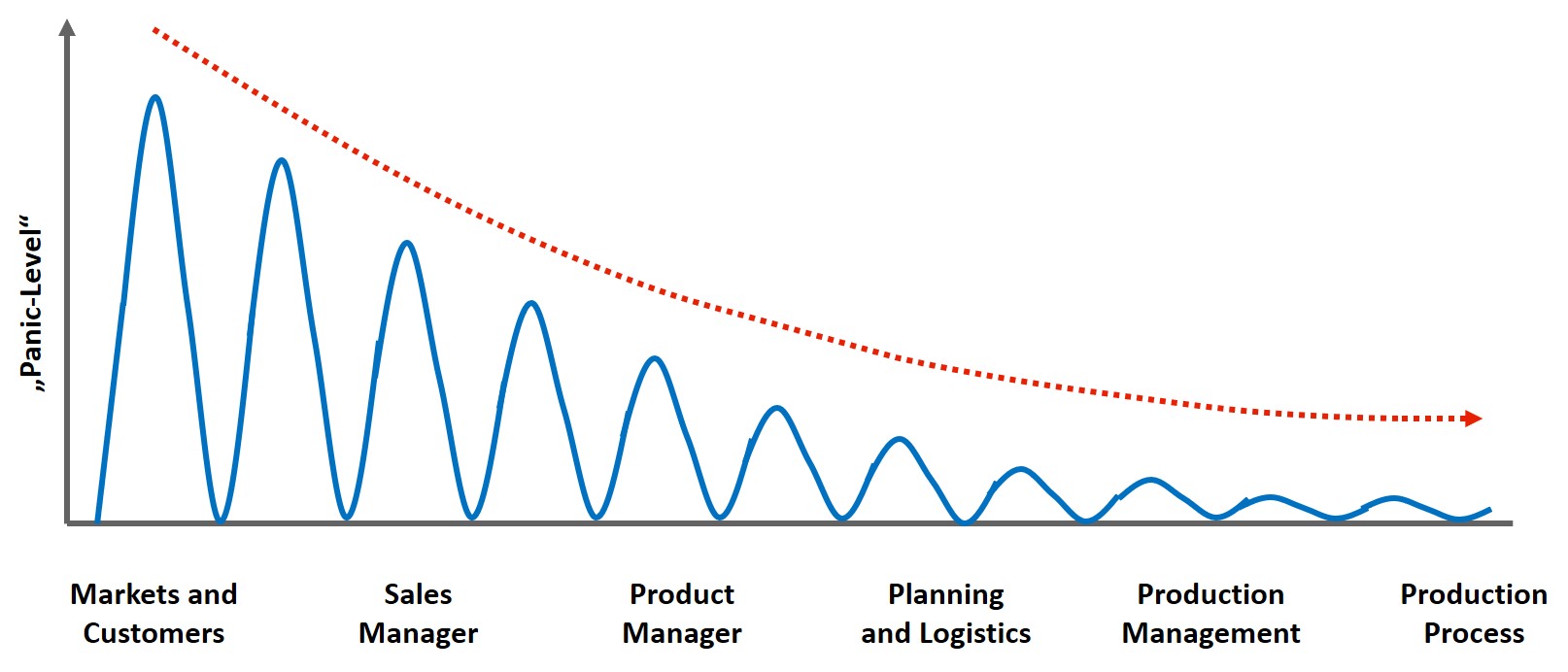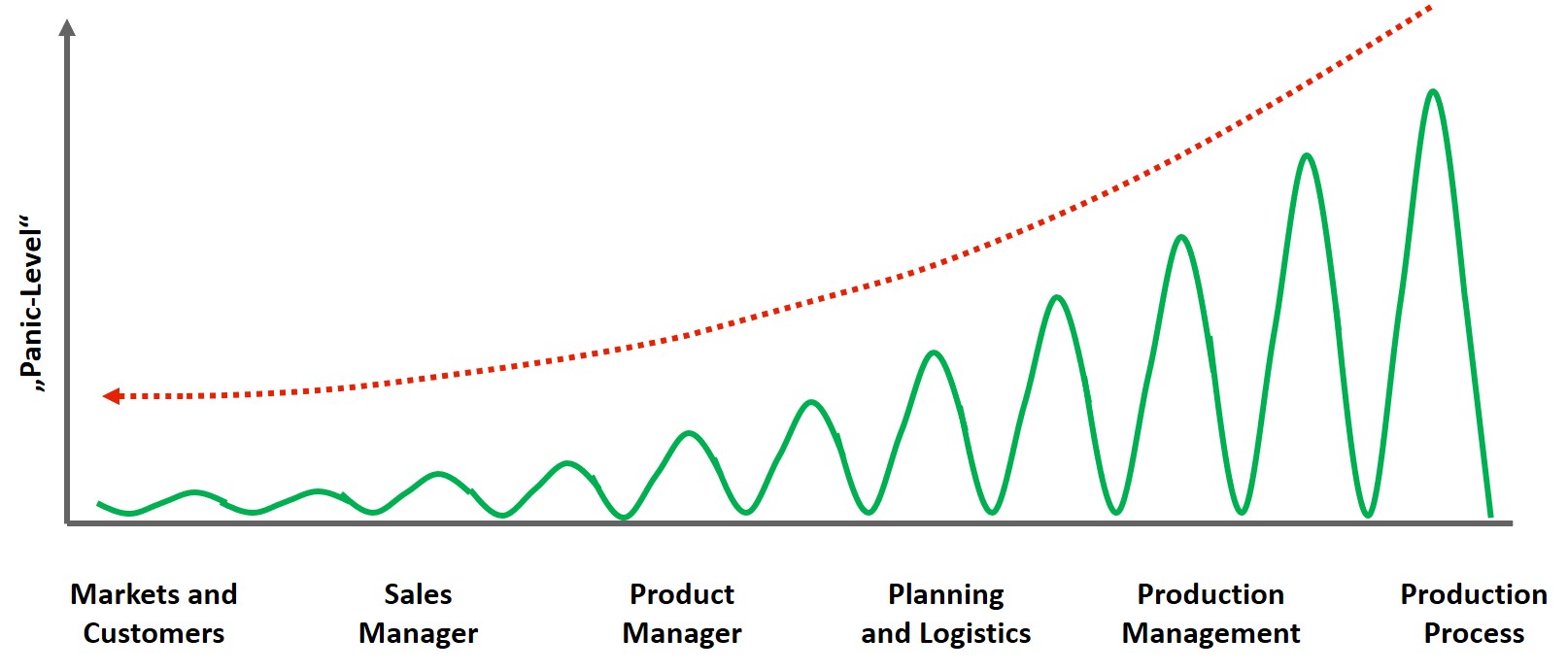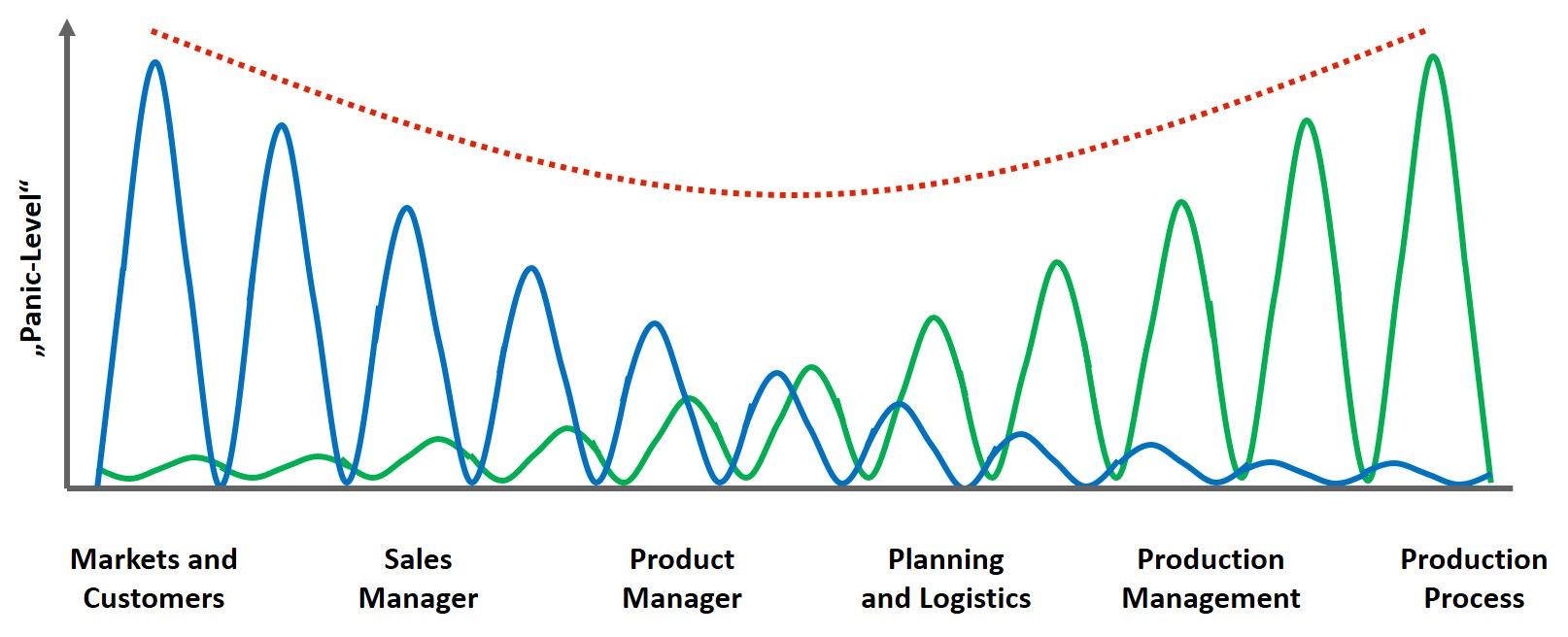Sales and Production
The two sides of success - a communication model
Author: Dr. Margit Sarstedt
Finding a good measure of information flow in a company - that's not always easy. The ups and downs of the markets and the back and forth of customer wishes must not affect the production process. And conversely, the daily surprises in production should not alarm the customers and the market. In this interaction between sales and production, middle management has a special task. A small graphical representation is intended to illustrate clearly the task of all participants as a kind of communicative attenuator.
-----
Oscillations and fluctuations in Sales
In the commodity business, the market has its ups and downs. With this, sales and management of a company have to deal with strategically. In customer-specific project business, additionally the details of the customer's requirements change constantly, at least until the conclusion of the contract, sometimes even beyond. Both aspects lead to a constant up and down, figuratively speaking to oscillations and overshoots, regarding quantity statements, price determination and timeline forecasts.
To get the job done right the sales department constantly needs technical information, typically from development as well as the production environment. As a result, these technical departments start to go back and forth as well. These oscillations in the flow of information (example: "we need 100 pieces - no, the order is canceled - oh, the order comes after all, it’s now 1000 pieces") have effects all the way down to the individual employee. They can, without counteraction, even build up. At the same time, however, production must be running, calm and undisturbed by the whirl that moves the sales colleagues. Otherwise, a quiet and orderly production process is out of the question.
Task of all intermediate functions in the chain ...
Customer / Market
Sales Manager
Product Management / Development
Planning and Logistics
Production Management
Shift leader
Production worker
Production process / Delivery
... is therefore to appropriately dampen these overshoots on market developments and customer forecasts within the communication chain.
So that looks something like this:

Oscillations and fluctuations in Production
But there are also confusions on the production side. For example, an unplanned down of a production machine, or a flu epidemic causes a delay in the production schedules. Also technical problems occur when the information of the development, despite all design for manufacturing measures, unfortunately turn out to be inappropriate for the manufacturing processes or the like.
Here, too, there are oscillations and overshoots which, in the event of an undamped and constantly updated passing on to sales (and thus indirectly also to the customer), cause widespread uncertainty among customers and the market in general. This too must be avoided, this too must be subject to a communicative damping by the intermediate functions.
So that looks something like this:

Momentum of Sales and Production – Swinging
Sales and production both have a good momentum, as far as the daily happenings are concerned. And in addition to the spread of information-overshoots themselves, it can also result in pendulum movements and an increase in the information-based panic level. The uncertainty in the market leads to uncertainties in production. This increasingly leads to errors, which of course gets known within the market. This leads to an additional uncertainty among customers. All understandable, but unfortunately a real unhappy spiral.

Tasks of the Middle Management
The intermediate functions, and thus essentially the Middle Management, have the role of communicative attenuators, and simultaneously in both directions. This essentially means to absorb the energy coming from both sides and to prevent it from passing through.
It is important to note that it is not intended to withhold information internally. On the very contrary, the orderly dissemination of information is essential in any company. Rather, it is about managing the potential changes – triggered by customer or market fluctuations on the one hand or events in production on the other hand – and holding them in frequency and amplitude in manageable magnitude. Not an easy, but an essential task.
Looking at it from both directions, it looks something like this:

Process flow optimization
The graphic representations show the importance of the intermediate functions as communicative attenuators between what happens in sales and what happens in production.
In my experience, unfortunately it is often the case that the intermediate functions themselves steer the flow of information towards a direct communication. With undoubtedly good intentions, the sales department is not seldomly told: "the fastest will be, you ask directly in the production department, if they can do it". Or, admittedly rarer, the production receives the answer "well, whether the order really comes, ... best will be to call the sales representative and ask directly".
This well-intended redirection of communication towards a direct contact may seem lean in a sense. And certainly the dangers of information distortion within the chain, comparable to the game of Chinese Whispers, will be reduced. Everyone is up to date, has the latest information directly from the source. And that's where the catch is, because this latest information is often already outdated after three hours at the latest. And if in the meantime, the partner (i. e. production or sales) has already acted on the information, and is rowing back on the new information three hours later, then there is the already described risk of a rising panic level. It is precisely the intermediate functions which ensure a healthy dampening of the back and forth of the information flow.
Of course, the intermediate functions must not be used so extensively that, due to a large number of relay stations, there is a distortion of the information content or delays in the information filtering and transmission leading to massive delays in the flow of information. These dangers are real and must also be avoided.

As so often, a healthy balance is important. I recommend a balance between lean and damped communication with - depending on the size of the company - a minimum of one to a maximum of three intermediate stages.
My conclusions – communication of oscillations within sales and production
- Oscillations and fluctuations of the market and customer wishes are unavoidable. Likewise, problems in production that affect delivery schedules and quality issues, despite all efforts, are sometimes inevitable.
- Throughout the business communication chain between sales and production, all intermediate functions must help to dampen information overshoots. The fluctuations in the flow of information must, so to speak, show a manageable measure in terms of frequency and amplitude.
- This must be managed simultaneously in both directions - a burden and responsibility especially for the middle management.
- I advise against a direct exchange of information between sales and production. Both functional areas are subject to the fast-paced fluctuations of their respective craft, and both sides need the information from the other side damped, otherwise an existing panic level will increase on both sides.
- On the other hand, of course, a too long chain of information hand-over should be avoided so as not to risk unnecessary delays and transmission errors.
- I recommend a healthy balance between a "lean communication" and a "damped communication" with - depending on the size of the company and on the issue at question - a minimum of one to a maximum of three intermediate stages (see graphics).
